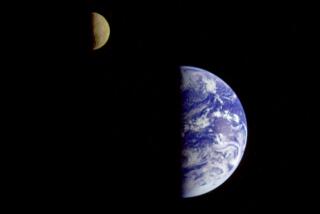The chances of an asteroid hitting Earth in 2032 have changed. But what’s the risk, really?

- Share via
The chances that an asteroid, known as 2024 YR4, could hit Earth in seven years have fluctuated recently, but experts aren’t preparing for the worst yet.
At the end of 2024, a NASA-funded telescope in Rio Hurtado, Chile, first spotted 2024 YR4 and a month later scientists concluded there was a more than 1% chance the asteroid would crash into Earth in December 2032.
When scientists first reported their findings in January, they expected the asteroid’s future trajectory and impact probability to change as observational data was collected and analyzed. That’s exactly what happened.
On Tuesday, astronomers reported that 2024 YR4’s probability of colliding with Earth increased to approximately 3%, which is unusual for a small asteroid that is only 130 to 300 feet wide. By Wednesday, that impact assessment dropped to 1.5%.
“But the impact probability remains small, so people should not really be too concerned about that,” said Davide Farnocchia, a navigation engineer at NASA’s Jet Propulsion Laboratory and the Center for Near Earth Object Studies.
Is it normal for the impact risk to increase so quickly?
Yes, there are scientific reasons why the impact probability change can increase suddenly. But the probability can also drop suddenly.
Initially you might have a small probability of impact because “you cannot rule out the possible collision with Earth, [but] at some point the probability will go to zero,” Farnocchia said.
When an asteroid is identified, scientists cannot pinpoint its exact future location, but instead can gather data to predict its location within a range. If that range overlaps with Earth, that’s when there’s a chance of collision, reported NASA Spaceflight.
With more observational data, astronomer’s predictions of the asteroid’s trajectory and future location become more precise.
The current range for the trajectory of 2024 YR4 — based on hundreds of collected observations — is still being assessed, so the range is large and currently overlaps with Earth. That’s why we’re seeing an increased percentage of possible impact.
As astronomers continue to collect data, the range could shrink so much that it no longer overlaps with Earth, and the chances of 2024 YR4 hitting our planet will become zero.
The current trajectory of 2024 YR4 is almost a straight line away from Earth, and astronomers will continue to collect observational data until it is out of sight. They have until early April to track the asteroid’s possible collision course and future location.
You can follow along with astronomers’ published findings on the Sentry webpage.
Where might the asteroid hit?
In the unlikely event that the asteroid’s trajectory connects with Earth, its point of impact would be somewhere along a “risk corridor” that extends across the eastern Pacific Ocean, northern South America, the Atlantic Ocean, the Arabian Sea and South Asia, according to the International Asteroid Warning Network.
Have we experienced an asteroid event like this before?
Yes, astronomers point to asteroid 99942 Apophis, 1,099 feet wide and first identified in 2004.
According to NASA officials, at the time of its initial sighting, Apophis was one of the most hazardous asteroids in the sky, with the threat of barreling toward Earth in 2029.
During early assessments of impact risk, Apophis reached a rating of Torino Scale 4, which is a scale for categorizing potential Earth impact events.
The 0-to-10 scale ranges from no hazard (Torino Scale 0), to normal (Torino Scale 1), to meriting attention by astronomers (Torino Scale 2 through 4), threatening (Torino Scale 5 through 7) to a certain collision (Torino Scale 8 through 10).
Upon gathering further observational data and assessment, scientists ruled out the impact probability for Apophis, for now, with a small chance of impact in 2068 declared unlikely.
As for 2024 YR4, it’s currently categorized as a Torino 3.
It is uncommon for an asteroid to be rated at Torino Scale 3, because that categorization only happens for asteroids that are larger than 65 feet with an impact probability of 1% or greater.
Even if this asteroid hits Earth, it could burn up in the atmosphere and become a much smaller meteorite before it lands.
Slightly larger asteroids may make it through the atmosphere but often crash at locations that cause minimal or no immediate damage, according to the United States Geological Survey. Many meteorites end up in the ocean or in open areas.
More to Read
Sign up for Essential California
The most important California stories and recommendations in your inbox every morning.
You may occasionally receive promotional content from the Los Angeles Times.











